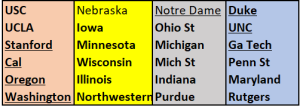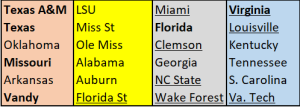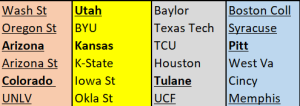By Larry Smith/IlliniGuys Staff
July 3, 2022
We've all heard it said a thousand times:
'You can't get to where you're going without knowing where you've been.'
The sports world was rocked to its core on Thursday when USC and UCLA bolted the Pac-12 - after being the marquee programs for it and its predecessors for 94 years - for the Big 10. It isn't the first time a "name" school has jumped the fence for the greener pastures of another league's backyard. But it is by far the biggest move in the television era and it will, without question, spark the largest shift we've ever seen.
Well, sort of...
Let's go back almost 100 years to a time when Alabama and Clemson, Georgia and Maryland, North Carolina and Vanderbilt were all in the same conference. Today, the Southern Conference is considered a mid-major; its football programs all play in the lesser FCS in Division I. But in 1925, it was a Southern powerhouse; 20 teams stretching from central Florida to the District of Columbia and from Tobacco Road to the Big Easy and the Louisiana Bayous. This was an era before commercial planes and personal computers, before professional sports expanded south and west, before the still teenaged NCAA decided to stage a national basketball tournament each spring, and decades before any of these schools would integrate.
College football was king in the South - let's be honest...it was all they had - and the Southern ruled the roost. But it was short lived. A dozen years after its inception in 1921, 13 schools west and south of the Appalachians left the Southern to form the Southeastern Conference. Two decades after that in 1953, seven more teams left to create the Atlantic Coast Conference. The mighty Southern's influence would continue to decline in the years that followed.
That's where we've been. Here's where we are and, more importantly, where we're going.
Today, we stand on the precipice of a return to those "glory days", if you will; a massive mega-conference or two of 20 or more schools. But unlike the train rides to play on Saturday afternoons before the sun went down and with the day's heroics described on local radio and daily newspapers in every town, these super leagues will be bi-coastal with players spending hours on chartered planes to play games that are broadcast as well as streamed to a global audience with their stats instantly available on your smart phone, tablet, or laptop.
If you're a Big Ten fan, you're strutting into your holiday barbeque this weekend like Rocky after his first kiss with that girl Adrian at the pet shop. It's your conference that's in the driver's seat and it's unlikely that anyone else will get a turn at the wheel in the biggest race of all: the money game.
USC and UCLA do more than give the Big Ten 16 teams, allowing it to equal the SEC in size. The two teams give the conference a foothold in the top four TV markets in the country. No other conference can or will match that, making the Big Ten the Shangri-la of college conferences to media outlets everywhere. And that's just the beginning.
While the Big Ten is saying that there will be no more expansion for now, you can be sure that's temporary. Both they and the SEC will get to at least 20 teams and probably beyond. It's why expanding the College Football Playoff is on hold. It's why conference leaders in every other league except these two are meeting right now and planning for the 'what if's'.
In this model, we are going to assume that both conferences expand to 24 teams (seems ridiculous, but don't laugh too hard) by the year 2030. And we are going to give the Big Ten first dibs, earned by their new west coast presence, market audience advantage, and the realistic prospect of doubling the $54 million that each SEC school received in TV rights money in 2021.
Now that the geographical barriers have been shattered, there are three key factors that are important to the Big Ten as they consider additional members:
Assuming the Big Ten swells to 24 schools, that would mean they will eventually create eight additional seats at their table. I will place my money on seven of them going to AAU schools in larger TV markets. The eighth team?
Notre Dame - the South Bend school is not in the AAU, but...it's Notre Dame. There have already been multiple reports - one from our own Brad Sturdy - that school officials have reached out to the Big Ten and its lawyers are trying to figure out a way to get out of its agreement with the ACC, which says if they join any conference before 2036, it has to be theirs. The Irish would be a perfect fit in the Big Ten and would make the Chicago TV market (#3 DMA) even more attractive to potential TV partners and sponsors alike. Watch this very closely; how Notre Dame gets out of its ACC deal (assuming it does) will set a precedent for other schools and could very well lead to the demise of the ACC.
The other seven teams - in this model - would come from among the following schools:
Stanford, Cal, Oregon, Washington -- the four programs from the Pac-12 that have reportedly inquired about making a move, even though there have been reports saying the remaining ten schools are committed to staying together. All four are AAU and all represent larger TV markets; San Francisco (#6 DMA), Seattle (#12), and Portland (#21) would bring a combined six million households. I initially thought Oregon would request Oregon State tag along and Washington would want Washington State as traveling partners, but neither school is AAU, so it would seem their chances would be remote. One thing to remember: the Pac-12 TV deal expires in June, 2024. While there will be an exit penalty for any of these four, the timing is perfect for any of them to jump in the coming months.
Georgia Tech -- Contractual obligations to the ACC come into play here, but Atlanta is a fast-growing TV market (#7 DMA) and Tech is an AAU school. Tech has long been considered a target for Big Ten expansion, but never has the possibility been as real as it is now.
UNC at Chapel Hill -- ACC school that belongs to the AAU and boasts one of the premier brands in college athletics. Though located in the Raleigh-Durham market (#24), you can include Charlotte (#22) in the equation as the Heels are of course hugely popular throughout the state. Are they interested? How costly would a breakup be? Would they move without Tobacco Road buddies Duke and N.C. State?
Virginia -- ACC school with high academics and an AAU member. Their profile fits the Big Ten to a "T" and, combined with Maryland, they would allow the Big Ten to completely dominate the Washington, D.C. (#9 DMA) market.
Duke -- AAU member that would solidify the UNC markets of Raleigh and Charlotte. Does the Big Ten need them? Not really. (Remember - basketball doesn't matter.) But if UNC demands a travel partner and if one of the other options doesn't pan out, they are a fit.
Texas & Texas A&M -- I know -- they're SEC schools. But they also (1) are AAU members, (2) are tied to the lucrative Dallas (#5) and Houston (#8) DMAs, and (3) have smart accountants. If the Big Ten was flirting with a billion-dollar TV package before USC/UCLA, how valuable are their rights now? How large is the price tag after adding several of the programs listed above? The SEC reportedly insists on a penalty up to $45 million dollars and two-year notice for members wanting to leave. If Big Ten schools stand to pocket $100 million each annually with a new deal, that's a small price to pay
So that's the Big Ten. What about the SEC? Look, in no way am I trying to diminish the power and allure of our friends to the south. They will be the base of the other super conference in college athletics and rightfully so. They will also expand and will command huge dollars in future media rights deals and everyone will be happy.
In this model, the SEC has many options. They could expand west and grab some Pac-12 schools. Arizona State (Phoenix is the 12th largest DMA) and Arizona have their issues in football, but that's an attractive market. Another possibility is absorbing several ACC schools and returning to a model very much like the Southern Conference lineup of yesteryear.
Assuming the SEC also goes to 24 teams, they could seat Clemson, Miami, Florida State, Virginia Tech, NC State, Wake Forest, Louisville, and either Duke or Virginia (depending on who goes to the Big Ten) at their newly expanded table. An impressive collection of athletic programs that would also draw huge interest among the media giants.
These moves would decimate the ACC and Pac-12. One possibility would be the Big 12 taking in the remnants of both and forming a third super-conference. The travel would be insane, but it is possible and would fulfill prophecy in having a premier level of college athletics broken into three leagues with 72 total members.
So, in 2030, the Big Ten could look like this - the first, bi-coastal mega-conference divided into six-team quadrants for scheduling purposes. For this model, we assume UNC wants its Research Triangle buddy Duke to come along, pushing Virginia out. (BOLD indicates AAU schools, underline notes projected added teams):

A similar look for the SEC:

For the Big 12, this hypothetical has them absorbing the rest of the Pac-12 and ACC and luring Memphis, Tulane, and UNLV for their TV markets to round out to 24 teams, though we hope they never schedule Boston College and Washington State to meet in any sport:

One more thing to consider: the TV deals for the College Football Playoff and Notre Dame's arrangement with NBC both expire in 2025. Three years in this space is really nothing. So while the Big Ten and others have time on their hands, there is an impetus to act quickly to have their future framework in place to maximize revenue.
As it stands right now, the Big 10 can claim a foothold in 10 of the top 25 DMAs in the country. If they expand as proposed above, that saturation jumps to six of the top seven DMAs and 16 of the top 25. Should Texas or Texas A&M come on board, the networks and media streaming platforms would come begging with checkbook in hand as the Big Ten would have the top nine DMAs in their pocket. Not even the NHL can say that.
There are more than 100 ways this could go; no one can predict where we will end up. When I began to get into the weeds with this on Thursday amidst all the USC/UCLA talk, I thought 18 schools would be the limit. But the more I researched it and talked with Sturdy and Mike Cagley on the IlliniGuys Sports Spectacular radio show, it's clear that we are headed for 20-team conferences and beyond.
For many of us - myself included, it's a somber moment. Just as train travel and games in stadiums without lights are a thing of past, so will be the short bus or van ride a couple of hours down the road to take on a familiar foe. A month ago, the idea of having teams from New York metro and California in the same conference seemed farcical. A decade from now, it may be the norm.
Welcome to the new world order of college athletics. Brought to you by the Big Ten.

539 Remembering Mike White with Chris White & David Williams
Listen
538 - Illini Upset 83-80 by Nebraska
Listen
12.12.25 - Illini BB Over Vols, FB Commit Michael Clayton, Jr & Michigan Fiasco
Listen
537 - Illini Defeat Ohio State 88-80 on the Road
Listen
536 - Illini Crush Tennessee 75-62 with Huge 2nd Half
Listen
12.5.25 - #21 Illini FB Recruiting Class & Illini Men's BB vs Tenn
Listen
535 Illini FB 2025 Signing Day Special - Insider View
Listen
534 Illini FB 2025 Signing Day Special - Scouting View
Listen
533 Illini FB 2025 Signing Day Special - Reporter View
Listen
532 - Illini Win 8th Game this Season over Northwestern
Listen
Illini Frustration in the Big Apple #531
Listen
Illini FB vs Northwestern for Season Finale, Illini BB vs UConn & Game Predictions - S5Ep16 - 11.28.25 - Seg 1
Listen
Illini Cruise to Victory Over UTRGV 87-73 #530
Listen
Illini Football Preview - Northwestern #529
Listen
Illini Upset by Relentless Badgers 27-10 - #528
Listen